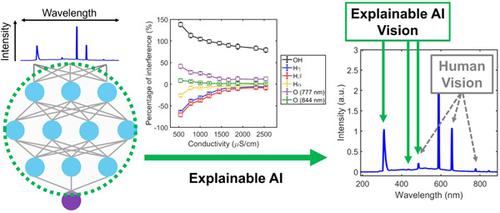当前位置:
X-MOL 学术
›
Plasma Processes Polym.
›
论文详情
Our official English website, www.x-mol.net, welcomes your
feedback! (Note: you will need to create a separate account there.)
Machine Learning with Explainable Artificial Intelligence Vision for Characterization of Solution Conductivity Using Optical Emission Spectroscopy of Plasma in Aqueous Solution
Plasma Processes and Polymers ( IF 2.9 ) Pub Date : 2021-09-13 , DOI: 10.1002/ppap.202100096 Ching-Yu Wang, Tsung-Shun Ko, Cheng-Che Hsu
Plasma Processes and Polymers ( IF 2.9 ) Pub Date : 2021-09-13 , DOI: 10.1002/ppap.202100096 Ching-Yu Wang, Tsung-Shun Ko, Cheng-Che Hsu

|
This study presents an explainable artificial intelligence (XAI) vision for optical emission spectroscopy (OES) of plasma in aqueous solution. We aim to characterize the plasma and OES with XAI. Trained with 18000 spectra, a multilayer artificial neural network (ANN) model accurately predicted the solution conductivity. Local interpretable model-agnostics explanations (LIME), an XAI method, interpreted the model through perturbing spectral features and fitting the feature contribution with a linear model. LIME showed that OH, Hγ, and Hβ emission lines were critical to the model, differing from the lines typically selected by humans. The results demonstrated that machine captured the spectral features neglected by humans. We believe using XAI for plasma OES analysis impacts the fields of plasma and analytical chemistry.
中文翻译:

使用可解释的人工智能视觉进行机器学习,使用水溶液中等离子体的光学发射光谱表征溶液电导率
本研究为水溶液中等离子体的光学发射光谱 (OES) 提出了可解释的人工智能 (XAI) 愿景。我们的目标是用 XAI 表征等离子体和 OES。经过 18000 个光谱训练,多层人工神经网络 (ANN) 模型准确预测了溶液的电导率。局部可解释模型不可知解释 (LIME),一种 XAI 方法,通过扰动光谱特征并用线性模型拟合特征贡献来解释模型。LIME 显示 OH、H γ和 H β发射线对模型至关重要,不同于人类通常选择的线。结果表明,机器捕获了人类忽略的光谱特征。我们相信将 XAI 用于等离子体 OES 分析会影响等离子体和分析化学领域。
更新日期:2021-09-13
中文翻译:

使用可解释的人工智能视觉进行机器学习,使用水溶液中等离子体的光学发射光谱表征溶液电导率
本研究为水溶液中等离子体的光学发射光谱 (OES) 提出了可解释的人工智能 (XAI) 愿景。我们的目标是用 XAI 表征等离子体和 OES。经过 18000 个光谱训练,多层人工神经网络 (ANN) 模型准确预测了溶液的电导率。局部可解释模型不可知解释 (LIME),一种 XAI 方法,通过扰动光谱特征并用线性模型拟合特征贡献来解释模型。LIME 显示 OH、H γ和 H β发射线对模型至关重要,不同于人类通常选择的线。结果表明,机器捕获了人类忽略的光谱特征。我们相信将 XAI 用于等离子体 OES 分析会影响等离子体和分析化学领域。











































 京公网安备 11010802027423号
京公网安备 11010802027423号